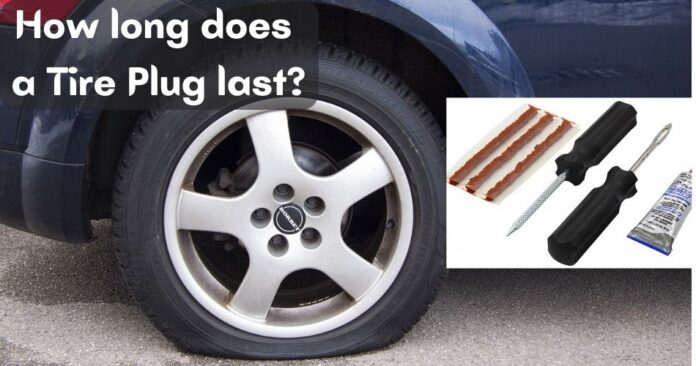How long does a Tire Plug last? Is it a permanent solution?
If you regularly drive your vehicle, you may have experienced flat tires somewhere between your journey, parking spots or even at your home. A flat tire is a common issue for cars, buses, trucks, bikes or any other vehicles.
Your tire may get flat or punctured due to sharp objects like nails, iron steel, rods or other foreign objects. If the penetration is strong, the tire gets completely flat immediately and disrupts your driving control. The tire may slowly lose air pressure in case of being penetrated with small nails due to which you get enough time for reaching a nearby workshop.
The impact generated by flat tires depends on the type of tire. The majority of vehicles today are equipped with tubeless tires instead of traditional tube tires. The key benefit of using tubeless tires is the convenience to repair them during puncture.
Tubeless tires do not get flat immediately due to the influence of liquids used inside the tires. However, tires with tubes lose air quickly and get flat suddenly after being penetrated by nails or other objects. It is also difficult to repair the tube tires because you need to completely remove the tire from the vehicle and take out the tube to patch it.
On the other hand, you just need a plug kit to get your tubeless flat tires to return to normal service. You can use a tire plug to get your flat tire working. You must be wondering about the tire plug or how long does a tire plug last.
In this article, we will find out how long does a tire plug last and the process to plug a tire hole. Besides, we will also explore the reliability of a tire plug and compare it with patching a tire.
Without further delay, let’s get started.
What does a Tire Plug look like?

As shown in the image above, a tire plug looks like a short strip of leather that can act as a protective layer for the holes in a flat tire. The leather-covered plug contains a soft and sticky (gummy) and unvulcanized rubber compound.
A tire plug can fully seal the holes as it fills the hole with the gooey unvulcanized rubber compound.
How to Plug a Tire Hole? (Step by Step Process using a plug kit)
You can purchase a tire plug kit which includes leather-covered gooey strips, T-handle Screwdriver, an Installer tool and Rubber Cement. With these materials, you can easily seal your punctured or flat tires.
You can go through the following steps to get your flat tire fixed with a tire plug kit.
Step 1: Find out the exact puncture location.
First of all, you need to locate the nails, iron rods or any other objects that are still stuck on the tire. If you do not find any of these foreign objects, you might have to search for holes. For that, use some soapy water on the tire so that it creates bubbles to make it easy for you to locate the hole.
Step 2: Remove the Foreign Object
Once you locate the nails, screws or sharp objects, you must remove them by using the side-cutter or a plier. Nails or screws might have strongly penetrated the tire due to which you may require to use more strength and also position the tire where you could get the most leverage.

Step 3: Insert the T-handle Reamer
After getting clear of the nails or screws, you need to insert the T-handle reamer (available in the Plug Kit) into the tire through the hole created by the nails or screws. You must use a twisting motion while inserting the T-handle into the tire.
With the twisting motion, a clean hole required for the plugging process is created. You can continue the twisting motion until a nice and clear spot is created. It requires considerable strength to insert the handle into the tire.
Step 4: Get your leather plug ready
Once the clean hole is created, you are now ready to insert the leather plug for which you have to use the installer tool available in the plug kit. The tire plug must be inserted into the installer tool via the eyelet as shown in the image below.
Step 5: Insert the Plug into the tire
In this step, you need to insert the plug into the tire using the installer tool. If your plug kit contains rubber cement paste, you can use it before inserting the plug into the tire.
Once you are ready, simply push the installer into the hole you created with the T-handle. The standard process is to insert the plug straight down until you observe almost a ½-inch of exposure.
The final process in this step is to twist the handle 90 degrees and pull it out gently. With that, the plug stays intact with the tire while the installer tool comes out nice and easy.
Step 6: Apply Air Pressure
The final step is to fill the tire with air pressure. If there is a workshop or a maintenance centre nearby, you can fill your tires to the proper PSI through the air compressor machine.

You can also use a portable air compressor or inflator to fill the air on the tires. A portable air compressor might be your best machine when you are stuck on the road without any assistance nearby.
How to Plug a Tire Hole Video Tutorial
You can watch this video tutorial to plug a tire hole correctly.
How much does it cost to plug a tire?
It is not that expensive to plug a tire if you have a plug kit or required devices for the installation. A repair centre or a workshop can charge you somewhere between $10 and $20.
A complete tire plug kit consisting of a reamer, installer tool, rubber cement and leather strips plug can cost around $9. In addition to the plug kit, you may require a portable air compressor whose pricing starts from $25.
How long does a Tire Plug last? Is a Tire Plug a permanent solution?
It depends on the quality of the tire plug when it comes to finding out ‘How long does a Tire Plug last?’. Besides, improper installation of a tire plug on your tire may not last long as you expected.
Let us suppose the quality of the tire plug is best and you have installed it professionally. In that condition, your plugged tire can perform well for more than 200 miles subject to road conditions, tire quality and getting punctured again.

For instance, if your tire is old and the grip is faded away, the plug may not last long. The only solution for this is to replace your tire with a new one as soon as possible.
A tire plug can’t be taken as a permanent solution because you can’t always rely on the plug to stick for a long time. If your tire quality is diminished, the plug may not stick for long period. Also, the faulty installation of the tire plug might result in the plug blowing out while driving.
Sometimes you might get a puncture or leakage on the tire sidewalls. A tire plug can be used to seal the sidewall puncture however, it might be risky due to the fact that the tire rotations could force the plug to blow out during high-speed driving.
How long can I drive with a plug in my tire?
As we discussed above, your plugged tire can perform well for over 200 miles if the plugging quality is best and installation is carried out properly. However, the tire plug performance can fluctuate depending on the road conditions, tire status and various other factors.
How to Plug a Tire Hole without a plug kit? (Is it possible?)
It is possible to plug a Tire Hole without a plug kit however, you need some basic tools including a screwdriver, rubber, scissors/knife, air compressor and glue.
You can go through the same process mentioned above to insert the rubber (used instead of a tire plug) into the tire and get it sealed with glue.
Can a Tire Plug fall out?
A tire plug installed into the punctured tire might fall out. But don’t worry because it happens only in the following conditions.
Condition 1: Tire Plug not installed professionally.
You need to insert the tire plug properly otherwise, it might fall out while driving. For example, the plug must be inserted enough with a ½-inch exposure. Rubber cement paste can be used if available.
Condition 2: Plug installed on Tire Sidewalls
Using a tire plug on the tire sidewalls is not recommended. It may blow out the tire plug due to the tire rotations during high-speed driving.
Condition 3: Incorrect Air Pressure
After installing the tire plug, you need to fill the tire with the correct air pressure. If the air pressure PSI (Pound per square inch) exceeds the top limit, it might compel the tire plug to blow out.
What is the alternative to a Tire Plug?
A tire plug is a perfect and convenient solution to repair the punctured tire on a tubeless tire. However, if you are looking for an alternative, you can go for a tire patch which is quite complex compared to the Tire plug.

Patching a tire requires the punctured tire to be removed from the rim and then patched with a rubber and a strong adhesive.
Tire Plug vs Patch (Is it better to plug a tire or patch it?)
The major difference between the tire plug and patch is the convenience. Patching is more difficult compared to plugging because you must remove the tire from the rim and then use rubber patching from the inside. A tire plug can be done from outside easily without removing the tire.

| TIRE PLUG | TIRE PATCH |
| Requires a tire plug | Requires a rubber patch |
| Can be done from the outside without removing the tire from the rim | A rubber patch must be inserted from the inside by removing the tire from the rim |
| Takes less time | Takes more time, tools and professionalism |
| Not recommended on sidewall punctures | Can be used to repair tires with sidewall punctures or leakages |
Conclusion on How long does a Tire Plug Last
All gasoline and electric vehicles are equipped with tubeless tires in today’s auto market. This makes it easy for customers to maintain or repair tires during puncture or leakage. Vehicle owners can easily repair their flat tire by using the tire plug kit or tire patching.
A tire plug kit is useful when there are no workshops or maintenance centres available nearby. It is a handy kit and can be used easily to repair a faulty tire. If the hole generated by nails or screws is small, it can be covered by the tire plug however, in case of big holes or tearings, you might need to patch the tire.
Plugging and patching a tire are the two options to repair punctured tires. It also depends on the status of the tire on deciding whether to plug and patch or replace it with a new tire. If the punctured tire has a small hole created by the nails, you can use a tire plug kit to maintain it because it does not require you to remove the tire from the rim.
The tire plug can perform well for up to 200 miles (320 kilometers+) if the plugging quality is best and is installed professionally. Also, the condition of the tire plays a major role in defining the longevity of the tire plug.




